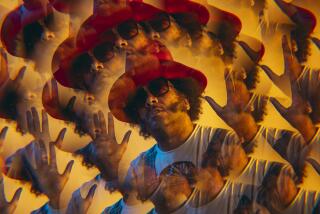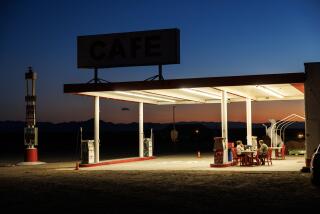It’s a long road
- Share via
Contrary to popular belief, the Corvette convertible the characters Tod Stiles and Buz Murdock drove on the existential black-and-white 1960-64 CBS series “Route 66” was not red and white.
“The original ones were blue,” said George Maharis, 83, who starred as the handsome, dangerous and hotheaded Buz, who set out to travel the country with Tod (Martin Milner), a clean-cut young man who had grown up in luxury only to discover after his father’s death that most of the money was gone.
“Jack Marta, who was a terrific cameraman, said the car was too light. He said when you are shooting up against the sky, particularly in the west there is too much ultraviolet light. ‘I can’t get enough lights on the guys.’ So we got a brown car.”
Herbert B. Leonard and Stirling Silliphant, who also were responsible for ABC’s hit “Naked City,” created the series, which examined the rebelliousness and restlessness of youth.
The series featured an amazing array of guest stars, including such veterans as Sylvia Sidney, Buster Keaton and Douglas Fairbanks Jr., and newcomers like Robert Redford, Keir Dullea and William Shatner.
“Route 66” also boasted a silky jazzy theme song from Nelson Riddle that hit the charts.
The series, said Bob Emmer, the co-founder and chief operating officer of Shout! Factory, which is releasing a DVD set of all four seasons on Tuesday, recalled the rebels without a cause of the day including James Dean and Marlon Brando.
“Here are these guys who are going across country,” said Emmer, who started watching the series as a young boy and was determined to own a Corvette one day. “They are going to get into trouble, and they are going to meet interesting people. It just sounded so cool.”
The trim and still-handsome Maharis left acting in 1993 and is now an impressionist painter. A delightful raconteur, he talked about the series over a turkey sandwich and fries at Mel’s Diner on Sunset Boulevard while the jukebox played rock ‘n’ roll tunes from the “Route 66” era.
The series, which was the first shot on the road across the country, was a grind for the actors and crew. “We were doing seven days a week, 16-, 17-hour days,” said Maharis. “In the beginning they said it would be five days a week, but that didn’t happen. We started backing up. They made 32 shows a year in those days. We were like a wagon train.”
Still, he said, doing the show on the road was less expensive than filming it on a sound stage in Los Angeles. “The show was budgeted for $100,000 an episode,” he said. “I don’t know how often they hit it.”
Sometimes accommodations were a bit crude. Maharis recalled shooting the second episode of the series in Grand Isle, La. “There were no hotels or motels,” he said. “There was nothing, so they got us houses.... I got up and wanted to take a shower. There was no water. I saw the guy who owned the house. I told him there must be something wrong with the plumbing. There is no water. He said that’s right. When it rains and it comes off the roof and into the barrel, you get water.”
Maharis, who earned an Emmy nomination for “Route 66,” left the series before the end of the third season. Glenn Corbett came on board and finished the season as Tod’s new cohort, Linc Case. The series lasted only one more season with the new combination.
Rumors were rampart that Maharis left the series over a salary dispute, his desire to do movies and even that he and Milner were having problems. “None of those were true,” said Maharis.
In fact, it was the lingering effects of hepatitis he contracted while doing an episode in Houston where he nearly froze in the water during night shoots. “They sent a doctor to the hotel, and he gave me a B-12 shot. I got [hepatitis] from the doctor. It changed everything.”
Maharis was in the hospital for a month. He was still recovering when he returned to the series because Gordon told him “they are going to cancel the show if you don’t come back.” But the hours were even longer and the first two episodes upon his return required him to be in the ocean.
“We got to where it was the episode with Harry Guardino in St. Louis,” said Maharis. “I was feeling terrible. They send me to a doctor and he said, ‘Go home. If you don’t go home, you’ll be dead.’ So I went home.”
--
More to Read
The complete guide to home viewing
Get Screen Gab for everything about the TV shows and streaming movies everyone’s talking about.
You may occasionally receive promotional content from the Los Angeles Times.







